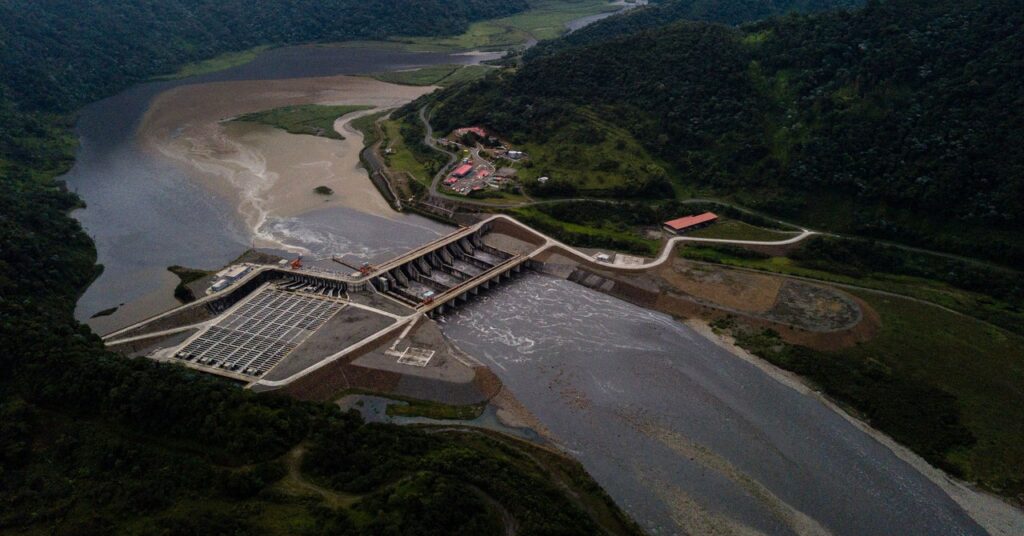Proano Avilés says that in times of water scarcity, Ecuador has few options to meet its basic energy needs, since it has no other major energy source. Colombia and Peru usually trade energy with Ecuador, but now they will not sell electricity because they are also forced to restrict water for their dams. And planning ahead for this is not easy, at least not with much confidence. The study projects that Ecuador’s hydroelectric power generation could range from a 55 percent decrease to a 39 percent increase between 2000 and 2071. Depending on the climate change scenario, Michelle says.
There are other factors that are causing the decline in Ecuador’s power plants. “There’s also more river erosion and sedimentation, which gets into the turbines and makes them less efficient,” Michel says. Deforestation and forest fires are also to blame. In Ecuador, some of the recent power outages were caused by the Coca-Codo Syncre Dam needing sediment. It is removed from the turbine input.
Despite hydropower’s vulnerabilities, it is expected that hydropower deployment will grow around the world. In Southeast Asia, countries such as Myanmar, Laos and Cambodia are increasing their hydropower capacity to meet growing energy demand. “Hydropower has great potential to expand electricity access to underserved populations, generate revenue for states, connect regions in power sharing agreements and sell electricity across borders,” Michel said. “But the challenges of climate change that we are seeing in Ecuador will also be challenges in Southeast Asia.”
Effective management strategies to address these climate challenges are essential and vary by region. According to Michel, one promising approach for high-rainfall regions is to increase the use of rainwater harvesting systems. Rainwater harvesting systems use catchments such as roofs, gutters, and storage tanks to capture and store heavy rainfall in localized systems. This helps replenish groundwater, meets agricultural and municipal needs, reduces the amount of water pumped from rivers and streams, and allows more water to be stored for power generation.
Moreover, while it would certainly be a costly and difficult undertaking, modernizing the grid would improve its ability to respond to fluctuations in demand, Proano-Avilés said. New infrastructure would be able to minimize energy losses and optimize the distribution of power, so less energy needs to be produced overall, and less water is needed.
Countries should also invest in other renewable energy sources to diversify electricity supplies and ensure backup when water levels are low. In Ecuador, for example, the government is offering a 100 percent income tax exemption for new investments in renewable energy, including wind and solar farms. Proano-Avilés notes this is an important step because private investment can fund renewable energy projects faster than the government alone.
Finally, energy and water conservation are essential measures no matter the region. Proaño Avilés has seen small businesses in Ecuador adhere to efficient energy management standards in preparation for future events. In some places, resource-use regulations are mandated by the government. Michelle points to Las Vegas as a case study. The city has implemented strict water-saving measures, including incentives for residents to replace lawns with desert-friendly landscaping and limited watering schedules. It also has a tiered water rate structure that increases fees for increased water use and an advanced water recycling system that treats and reuses wastewater.
“I think this has a powerful demonstration effect for policymakers in other cities and consumers across the country because they can see what’s going on,” Michel said. “It sends a signal that, yes, we have policies and approaches that can help solve these challenges.”
As climate change alters weather patterns and increases the frequency of extreme weather events, proactive and comprehensive management is essential to prevent widespread energy crises, whether in South America, the United States or Asia. For Ecuador, its energy future depends not only on its ability to meet immediate challenges, but also to plan for long-term resilience. “I think we’re moving in the right direction, but I don’t know if it’s at the right pace,” Proaño Avilés says. “I don’t know if we’re moving fast enough.”


